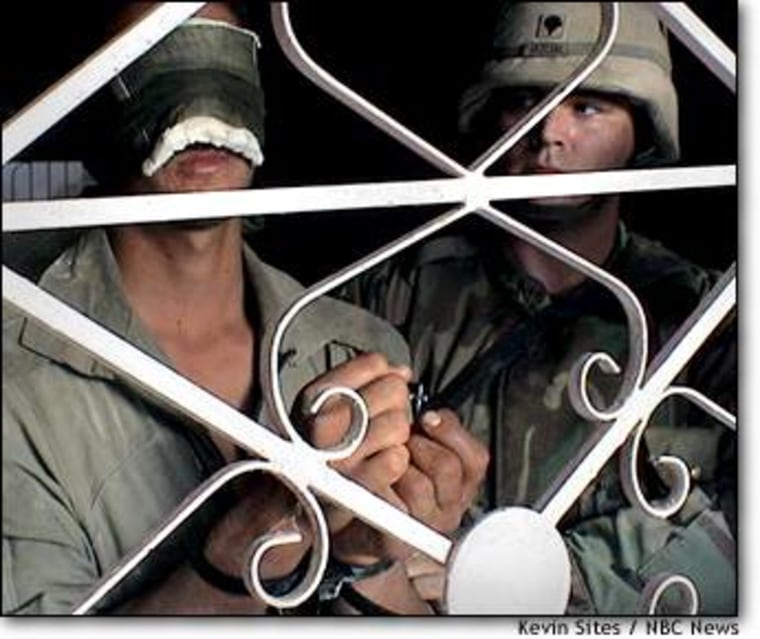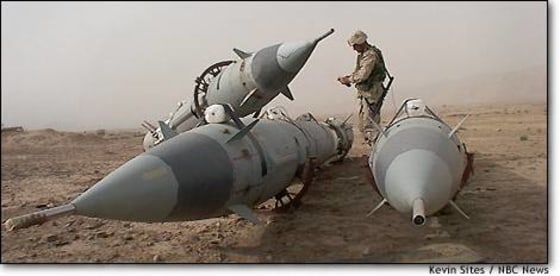The combat engineers of Battalion 299 Charlie Company were doing what they like doing best: blowing things up.
On Saturday, east of the Iraqi town of Baji — a town north of Saddam Hussein’s hometown of Tikrit — the cache was a bunch of Russian-made SA2 surface-to-air missiles strewn across the desert like pixie stix.
The 299’s commanding officer, Lt. Colonel Mark Huron, said the mission, though typical, was an important one as the missiles contain certain components that, “if they fall into the wrong hands could be fashioned into an I.E.D.”
That’s Army lingo for improvised explosive device — the deadly weapon of choice by insurgent forces that have been attacking U.S. troops every few days since President Bush declared the end of major combat on May 1. More than 100 soldiers have died in Iraq since then, many the victim of the hard-to-detect I.E.D.s.
In a country awash in weapons and ammunition, these devices have been rigged with everything from grenades to artillery shells. But the SA2’s could up the ante.
The telephone-pole length missiles each carried a 300-pound warhead. The engineers packed them with white bricks of C-4 plastic explosives, equivalent to about a stick and a third of dynamite.
“It takes a special kind of soldier to do this work,” said Sgt. Anthony Jackson of Akron, Ohio, as he plugged in silver blasting caps and spooled out green detonating cords.
For the first blast of the day there were two intact missiles and 23 separated warheads to be destroyed. The squad ran “det” cord from the half-dozen bricks of C-4 on each missile and the two bricks on each warhead to the primary lead lines. It was a giant cat’s cradle that carried an electric pulse to set off the plastic explosives and then the warheads.
“Don’t get me wrong,” said Sgt. Thomas Archer, “the bang is great, but the shockwave is where it’s at. You feel that shockwave and you know you’ve done your job. There’s not going to be anything left.”
HAIL MARY SQUAD
In postwar Iraq these guys are the “Hail Mary” squad — ready to do what they’re asked, from treating drinking water, to building bridges, to destroying weapons caches that could be used against coalition forces.
Sgt. Major Wells has been in the Army for 23 years and doesn’t plan to quit until they make him. “Why should you leave a job when you’re having fun?”
Their portfolio is as broad and diverse Leonardo DaVinci’s—and like the renaissance genius, they use both sides of their brains — creative and logical to accomplish their mission.
After all the SA2’s were rigged, Charlie Company needed to put in a blast request to Division Command. It’s much more than a Fourth of July fireworks show — so airspace has to be cleared along with people, houses, and flocks of sheep. Once, the engineers explained, they detonated dozens of warheads in one shot and the explosion was so large it was seen by NASA satellites.
But on Saturday, there was a snag. They were in a desert valley and their radio communications couldn’t reach Division headquarters in Tikrit. So a four-man squad was dispatched up the hill in a Humvee to try and make radio contact.
But as they’re driving, three men firing from a nearby ravine ambush the squad. Luckily for the Americans, the attackers were bad shots. AK-47 rounds went wide and a rocket-propelled grenade sailed overhead.
The engineers returned fire with the guttural thumping of the 50-caliber machine gun mounted on the vehicle. The suspected attackers fled but were quickly captured. Dozens of spent shell casings were spotted but no weapons were found in the ravine.
‘QUICK AND VIOLENT’
Within minutes the Iraqi men, all in their early to mid-twenties, began to turn on each other. They not only admitted their guilt but also pointed to a nearby house where they said accomplices were hiding out.
Lt. Colonel Huron told Capt. Larry Lyle to come up with a plan for a raid. “Larry,” Huron said, “just make it quick and violent.”
Violent is a tactical term, rather than adjective. For soldiers it means a show of overwhelming force that immediately convinces an adversary to surrender rather than fight.
While Lyle prepared the raid — the blast request came through. A voice came over the radio, “Fire in the hole, Fire in the hole, Fire in the hole.”
Seconds later, a stretch of desert the length of two or three football fields erupted in orange flame and black smoke. Shards of the missile casings flew through the air. A black mushroom cloud formed.
DETONATION ENDS, RAID BEGINS
As soon as the detonation is over — the raid began. Lyle and his team rolled on the house. Soldiers covered the rear exits while others piled in through the front door and into the backyard.
Six men, who moments earlier were sitting on Persian carpets, smoking sweet tobacco from a large water pipe called a hubbly bubbly, were soon face down in the grass with M-16’s trained on them.
The engineers were forceful, but not brutish in their approach. The house was searched and a few weapons are found.
“Looks like we got a little pistol looks like 38 special,” Lyle said. The weapon was loaded and he opened the cylinder to empty the rounds. The soldiers also found an AK-47 with many empty magazines.
“This could’ve been a weapon used to shoot at my guys,” he said, although he agreed that it wasn’t unusual for an Iraqi household to have a large number of weapons on hand.
“That’s why we’re going to bring in the other guys and have them make an I.D,” he said.
I.D. PARADE
The three men captured after the attack were brought into the backyard, bound and blindfolded. The engineers had no translator and tried to pantomime what is to be done.
They removed the blindfolds off and pointed, one at a time, to each of the men who had been sitting in the backyard. They told the three to either nod “yes” or shake their head “no,” to indicate which of the other men were also involved in the attack. They implicated an older man in a gray Arab dish dash robe, another younger man in a red kaffiyeh headscarf and a nicely dressed middle-aged man who spoke a little English.
He was the most distraught. “Please,” he said, as he is pulled to his feet and moved back from the others. “I am teacher.”

Capt. Lyle touches his arm. “Sir, we’re just going to question you. If you’re innocent you’ll be released.”
The engineers snatched the younger man’s red kaffiyeh from his head and use a knife to cut it in strips. They bound the men’s hands with it. The engineers checked the men’s shoulders for the tattoos of Saddam’s Fedayeen militia. None were found. Then they cut up an orange bath towel found in the house and blindfolded them. Loose threads hung down in their faces as they were walked outside to a waiting truck.
Second Lt. Adam Rasmussen told his squad to move them out, but not to treat them roughly.
The six were set to be questioned back at the 299’s operating base — a half-finished palace in Tikrit that Saddam Hussein was having built for one of his daughters.
The men have renamed it Forward Operating Base Omaha and have painted an American flag in the shape of Iraq over a relief sculpture of the ex-dictator’s face.
(Four days later, only the three men captured immediately after the attack remained in custody in Tikrit, a U.S. spokesman said Wednesday.)
For both the Iraqis and the engineers of the 299th Saturday’s events had been another long day’s journey into uncertainty.
It was, their faces betrayed, a strange and unfamiliar place within this conflict that shifts from moment to moment like shadows in the desert.
(NBC’s Kevin Sites is on assignment in Iraq. His dispatches, more photographs and other observations from Iraq can be found on his personal blog, kevinsites.net.)
